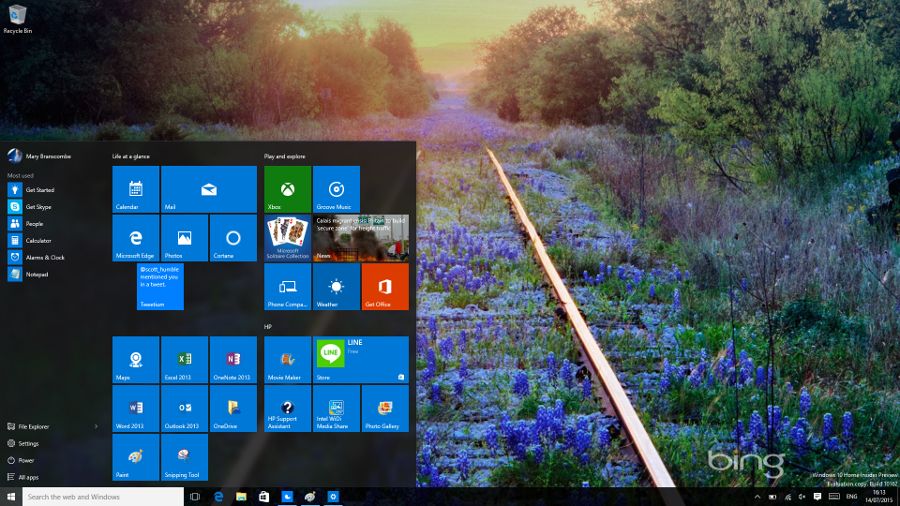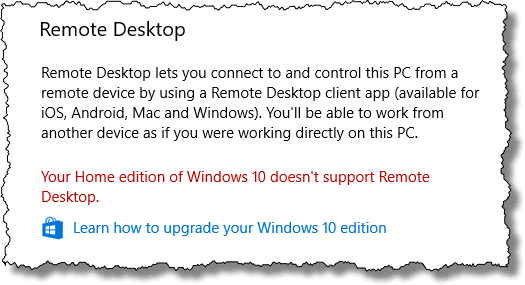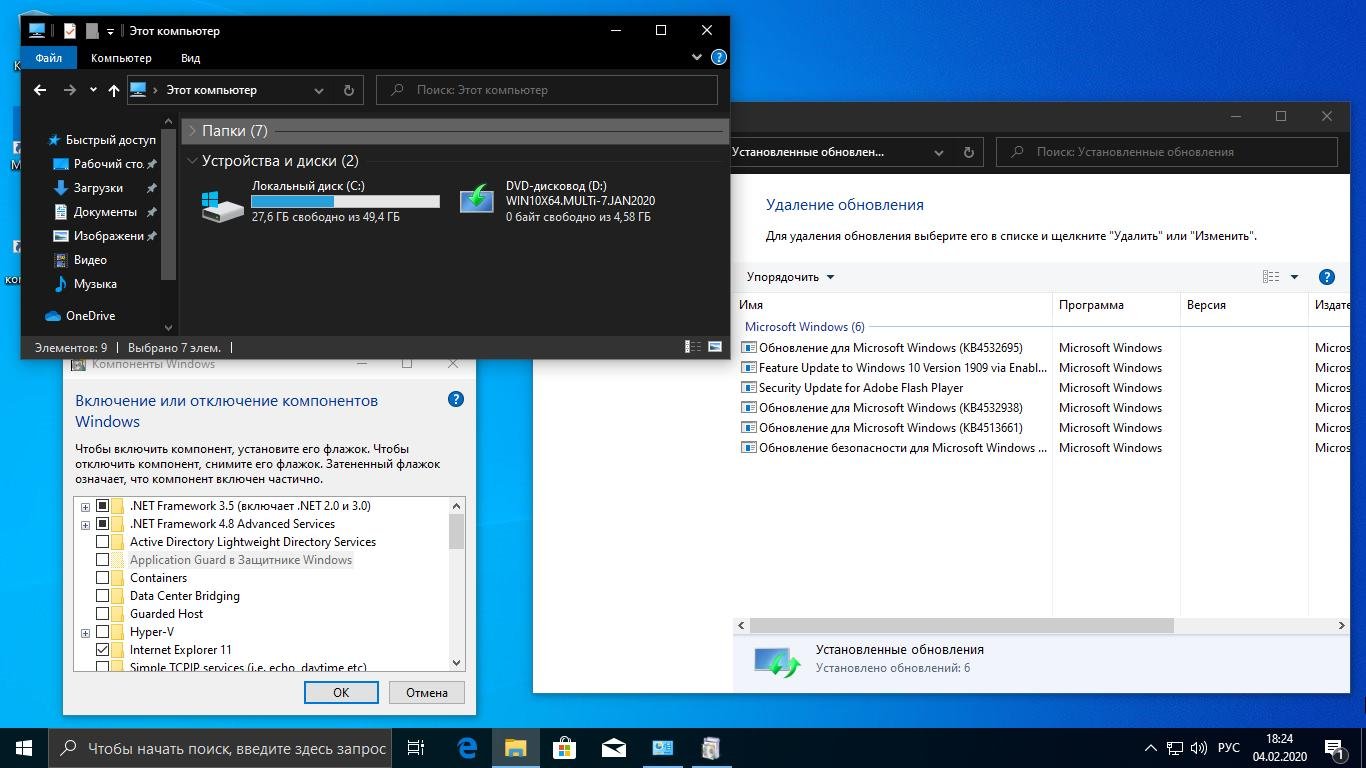Furthermore, Windows 11 Home will likely offer limited functionality and features when it comes to business management and deployment software. Furthermore, the 10 Pro has extra security apps known as Device Guard coupled with Secure Boot to curb malicious code hijacking a user's PC. It also includes business-oriented features such as remote desktop for accessing your computer from other locations via an android mobile device. And, there's an assigned access feature that grants employees or co-workers access to certain apps on your computer. The Home version will suffice for majority of the individuals using Windows at home. The Pro focuses entirely on security and compatibility, and ease of use.
Both the Windows versions come with support for Microsoft Passport, device encryption, side-loading of business apps, and mobile device management. Along with that, both versions can be easily upgraded to Windows 10 Education Edition. 10, called feature updates, are released twice a year as a free update for existing Windows 10 users.
Each feature update contains new features and other changes to the operating system. The pace at which a system receives feature updates is dependent on the release branch from which the system downloads its updates. Windows 10 Pro, Enterprise and Education can optionally use a branch that receives updates at a slower pace. These modes can be managed through system settings, Windows Server Update Services , Windows Update for Business, Group Policy or through mobile device management systems such as Microsoft Intune. Hyper-V is a Windows-only hypervisor used for running virtual machines on CPUs that support virtualization. While Hyper-V is included with your Windows 10 Pro license, it needs to be downloaded and installed separately.
In addition to the security features available to Windows 10 Home, end users on Windows 10 Pro also have the option to use BitLocker device encryption if the encryption protocol is supported by their hardware. Windows 10 Pro users also have the full range of management and deployment options for enterprise customers. As business users often deal with especially sensitive information, there are also some extra security features in Windows 11 Pro. This feature encrypts data stored on your hard drive so no one else can access it. Even if your computer is stolen, your files are protected from users other than yourself. However, whilst that's the case, we can still extrapolate some of the differences based on Windows 10 versions.
For a start, Windows 11 Pro will likely offer additional security and business-tailored features when compared to the home version – as per Windows 10. Looking at the Windows 11 predecessor, Win 10 Pro did offer BitLocker device encryption and Windows Information Protection – something the Home version simply couldn't boast. These are two great features that help increase the security benefits of Windows 10 Pro over Home – and we expect to see similar differences with Windows 11. Microsoft has offered a Pro version of Windows since the XP days, bringing with it additional features for power users that Home doesn't offer. Here's a breakdown of the most useful features that you get with Windows 10 Pro, as well as free alternatives, when applicable. Rather than classifying as a full edition of Windows 10, "S" is a mode that runs on either Home or Pro versions of the OS.
It's designed to optimize security and performance, and it runs only apps that are downloaded from the Microsoft Store and browses the internet through Edge. Anyone with Home or Pro editions can make the upgrade at any time, but it's not a forced update. You can also switch out of S mode at any time, reverting back to Home or Pro, though you can't switch back once you've gone one way. This edition of Windows 10 mirrors the feature set of Windows 10 Pro with a few differences. The key difference is that this version of Windows 10 supports workstations with up to 6TB of memory and 4 CPUs.
Most fundamentally, Win 11 Home is unlikely to offer any business management and/or deployment software. This is the case with the Windows 10 Home version, whereas Win 10 Pro customers gain no less than 10 additional benefits. Some of these include mobile device management, access to the Microsoft Store for Business, and the Windows Update for Business feature. Microsoft is yet to confirm the exact Windows 11 Home and Pro differences, though it's currently possible to speculate based on how the Win 10 versions differ. Both versions offer all of the same fundamental features, though, in terms of security, they differ slightly. Win 10 Pro boasts BitLocker device encryption and Windows Information Protection over the Home version.
The former allows users to lock a lost or stolen device down, while the latter helps to prevent data leakage. Windows 11 Home requires a Microsoft account and an internet connection to set up, whereas Win 11 Pro does not. Outside of this confirmed difference, Windows 11 Pro is likely to offer additional security and business features over the Home version. Windows 10 Pro adds several advanced features, including Hyper-V for virtual machines, BitLocker device encryption, Remote Desktop for remote access, and a suite of features intended for business use. Pro users can get updates from Windows Update for Business, which includes options for scheduling updates so they don't reboot PCs at important business times.
Several features in Windows 10 Professional are aimed squarely at the business market. Domain join, for example, allows you to bring in your own PC and connect it to the office domain. Group policy management allows an IT admin to control which PCs do what.
And if you're running an ancient Web app at work that doesn't work with Edgeor Internet Explorer 11, the Enterprise Mode Internet Explorer allows you to drop into an Internet Explorer 8 mode inside your browser. Likewise, if your business needs specialized enterprise apps, an admin can lock down the Windows Store to make sure employees get those, and nothing else. There's also the ability to join Azure Active Directory, with single sign-on capabilities.
Microsoft has offered Pro versions of their OS since Windows XP. Similar to every other Pro model, the Windows 10 version is designed with business professionals in mind. It includes the core Windows 10 Home OS, but with a handful of additional security, productivity, and business management features. As you can see, for most standard users, Windows 10 Home contains all of the features you'll want or need including the cool new additions like Cortana, Edge Browser and improved Biometric security.
Similar to previous versions of Windows, Pro versions of Windows 10 come with features intended for businesses and connecting to professional networks such as Domain Join and Remote Desktop. This is the version that is pre-installed on nearly every Windows 10-based device. Windows 10 Home does benefit from being the entry level version of the operating system, however, because new security features and enhancements end up on this edition. Of course, this version also lacks all the hooks to make it a manageable end point for enterprises – that is why it is called Windows 10 Home.
I have tested this scenario multiple times on hardware that originally shipped with Windows Home and was upgraded to Windows 10 Pro. When prompted, be sure to choose Windows 10 Pro as the edition to install. Windows 10 Education includes features from Windows 10 Enterprise that are ideal for advanced security, and the comprehensive device control and management needs of today's educational institution. Windows 10 Education also enables simplified deployment in the education space; this edition provides a direct path for many devices to upgrade from Windows 10 Home or Windows 10 Pro. The professional version of Windows 10 includes many extra features designed for businesses. It has virtually everything offered by Windows Home, plus additional security and management services.
This version of Windows 10 is typically purchased in bulk by companies or schools, though you can configure desktops and laptops to include it versus using Home. This edition was introduced in July 2016 for hardware partners on new devices purchased with the discounted K–12 academic license. It also features a "Set Up School PCs" app that allows provisioning of settings using a USB flash drive, and does not include Cortana, Microsoft Store suggestions, Windows Sandbox, or Windows Spotlight. The Windows 10 Home edition is light on professional and business features, choosing to shed some extra security but offers the familiar Windows experience most users are after. It replaced Microsoft Virtual PC to efficiently create virtual machines on Windows 10.
It is a native hypervisor which allows you to run multiple operating systems using virtual machines on Windows. Virtualization is a significant update to the Pro users who may need to run multiple operating systems without dedicating physical hardware to each of their machines. Other features like group policy management, Assigned Access, and the ability to join a domain are unlikely to be very useful outside of the workplace. Assigned Access allows an admin to lock down Windows and allow access to only one app under a specified user account. Group Policy meanwhile allows you to restrict access to any number of Windows features and configure any setting within the operating system.
While this is great from an admin perspective and a good way to set a co-worker's wallpaper to something fun remotely, it's not very useful in a home environment. The reasoning is that RDP is meant to assist business professionals who find themselves working remotely from time to time. It creates a secure connection between work and home computers that allows the user to access files, programs, and other sensitive material. This isn't a particularly useful feature for those just looking to game, and there are plenty of free or low-cost options available with similar functionality if you need it. The Windows 10 N and Windows 10 KN editions have had media-related technologies stripped from the OS. This includes features such as Windows Media Player, apps such as Groove, Movies & TV, Voice Recorder and Skype.
Instead the end user of these two editions of Windows 10 must install other software to regain that media functionality on their devices. The additional feature referred to in the Pro version is the built-in function of Windows, and most of these functions are tools used by system administrators. The features included in Windows 10 Pro are Bitlocker management, Windows Hello, Windows Information Protection, Windows Hello, and user account management features. Remember that Bitlocker is a Microsoft encryption utility that helps protect your data by encrypting it.
Comprehensive device management is one of the main advantages of Win 10 Enterprise. You can set up the computer to boot into your dedicated application and you control updates. In IoT applications, like digital signage, manufacturing automation, medical devices, and M2M communication, an automatic update could be detrimental to your operation. With Windows 10 IoT, you can decide to delay updates, install them as in-place upgrades or even skip updates all together.
Win 10 Pro is a bit more expensive than Win 10 IoT, because it's a more adaptable operating system. It's designed to be applicable to lots of different scenerios, with only light or no customizations needed. Win 10 IoT Enterprise is for specific, dedicated applications, where an automatic update could cause serious interruptions in your workflow. Win 10 IoT is built for IT professionals, whereas Win 10 Pro can be more easily used and managed by your whole staff. If you need re-imaging or to re-install the OS with no license headache, Windows 10 Pro is probably better for you. Licensing on Windows 10 Pro is straightforward as there is a 25 character product key that can be typed in to re-activate the hardware after any re-install.
Windows 10 in S mode is one of the newer addition types which is designed to offer a more lightweight version of the OS for the most efficient performance. As such this feature-limited Windows 10 is ideal for affordable devices used in situations like education. This also works well as a less process intensive platform for older hardware and mobile devices like tablet computers. It creates a lockdown environment to restrict users to run a Universal Windows app or when they are building a kiosk PC. Assigned Access can be configured to set up single-function devices, which allows an app of your choosing to be run in full-screen mode. Many home users were offered the option to upgrade to this new operating system as early adopters so many people upgraded for free when they had the opportunity.
But many Windows users also chose to stay on the older versions such as Windows 7 and Windows 8. Also, many business-class customers chose to wait to upgrade their operating systems with their hardware. There are still substantial numbers of Microsoft customers who have not upgraded to Windows 10. Upcoming changes in other Microsoft Products will soon guide more users into an upgrade.
Here are the differences between the two main versions of Windows 10, Home and Pro, which should help anyone planning an upgrade to make an informed choice. Through the above instruction, you know the extra features in Windows 10 Pro are really designed for businesses. The benefits of the Pro version focus on security and compatibility.
However, the value of these features will come down to whether you actually need them or not. If most of these features are meaningless to you, that's no surprise. Windows 10 Home features can suffice for the vast majority of users. If you just want to browse the web, do a little work, and manage their media files, it's already quite good. Of course, the bulk of the differences between Home and Pro editions of Windows 11 are for businesses.
Most device management capabilities aren't available in Windows 11 Home at all. Windows 11 Pro, however, supports things like Group Policy, which lets IT admins configure certain policies for groups of devices in one go. There's also Windows Update for Business, which lets companies control how updates are rolled out to their users to avoid unexpected issues. Another difference that will be noticeable for business users is that Windows 11 Home PCs can't be joined to Active Directory. Active Directory solutions are necessary for managing business devices, such as configuring access to certain resources, deploying apps, and so on. Those are all professional tools, so they don't make sense for most Windows 11 Home users.
Windows 11 Pro version will almost certainly offer a set of enhanced security features compared to Windows 11 Home. Expect to see to BitLocker device encryption and Windows Information Protection baked into the Pro version. These haven't appeared in any prior Home version and we wouldn't expect anything different here.
If history tells us one thing it is that we can probably anticipate the main differences between Windows 11 Home vs Pro. It's commendable on Microsoft's front to pack Windows 10 Home with all the core features, considering it's the basic version. Windows 10 Home should work fine if you just care about the new attractive features like Cortana, Timeline, Windows Hello, etc. Microsoft has also added some security features in the Home edition like Microsoft Passport, device encryption, and more. Virtual desktop is finally available on Windows 10 and the good news is that both Windows 10 Pro and Home support it.
Along with virtual desktops, Timeline is also available on both the Windows 10 versions. Timeline allows you to access all your browsing history from all devices including Android and iOS smartphones. Assigned Access is another Pro feature that you won't find on the Home edition. It lets you set up a kiosk computer with access to certain apps and environments only. The user cannot access anything beyond what is assigned on the PC. Basically, the user won't be able to interact with the start menu, taskbar, Windows settings, or anything that you have disabled.
One of the best security features of Windows 10 Pro is that it comes with BitLocker. BitLocker is a disk encryption program, which protects data by encrypting all the volumes in a drive. In case you are unaware, encrypting the drive data makes your data unreadable by unauthorized users.
The least expensive of the Windows operating systems is Windows 10. It's $139.00 and designed for the home or consumer user that doesn't need the advanced features that the Pro version offers. Windows 10 Pro includes access to business versions of Microsoft services, including Windows Store for Business, Windows Update for Business, Enterprise Mode browser options, and more. These versions include extra features to buy and upload content in bulk.
Options for virtualization include Remote Desktop compatibility, Client Hyper-V, Shared PC configuration, Azure Active Directory, and more. It comes with a number of new features including the revamped Start Menu. The company decided to chop it off from Windows 8 three years ago, but on popular demand, this feature is making a return to the desktop operating system. You also get a full-fledged version of Cortana, the digital voice assistant formerly exclusively available on Windows Phone. Other than that, the Home edition also gets you features like Battery Saver, TPM support, and company's new biometrics security feature called Windows Hello.





























No comments:
Post a Comment
Note: Only a member of this blog may post a comment.